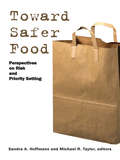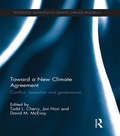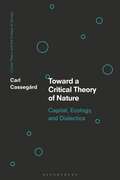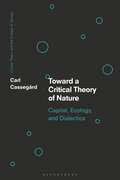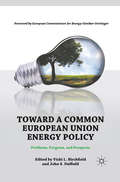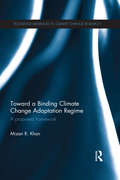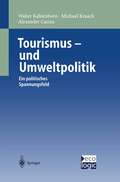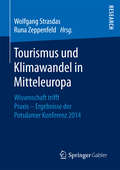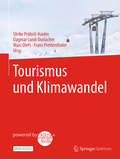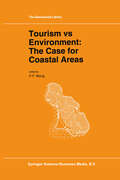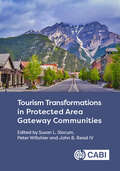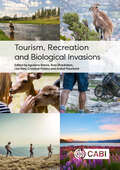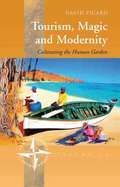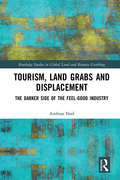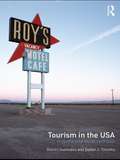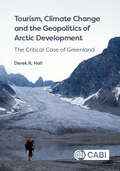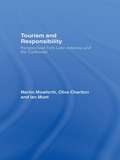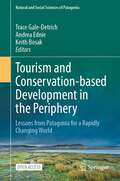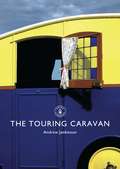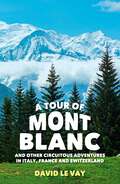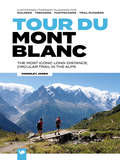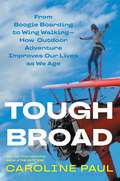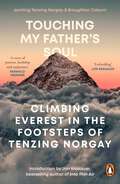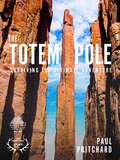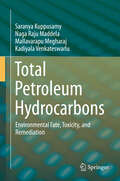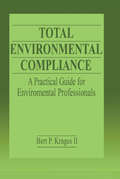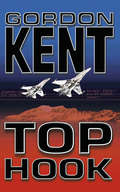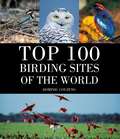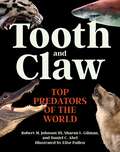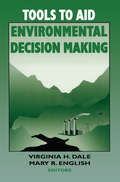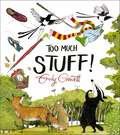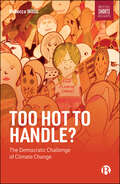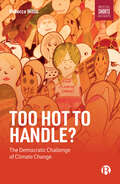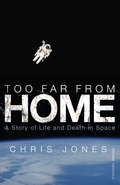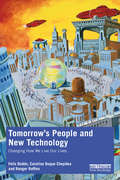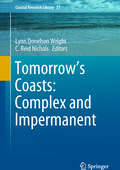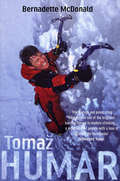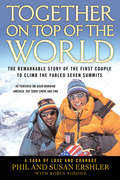- Table View
- List View
Toward Safer Food: Perspectives on Risk and Priority Setting
by Sandra Professor Hoffmann Michael R. TaylorIn 1998, a National Academy of Sciences panel called for an integrated, risk-based food safety system. This goal is widely embraced, but there has been little advance in thinking about how to integrate knowledge about food safety risks into a system- wide risk analysis framework. Such a framework is the essential scientific basis for better priority setting and resource allocation to improve food safety. Sandra Hoffmann and Michael Taylor bring together leading scientists, risk analysts, and economists, as well as experienced regulators and policy analysts, to better define the priority setting problem and focus on the scientific and intellectual resources available to construct a risk analysis framework for improving food safety. Toward Safer Food provides a common starting point for discussions about how to construct this framework. The book includes a multi-disciplinary introduction to the existing data, research, and methodological and conceptual approaches on which a system-wide risk analysis framework must draw. It also recognizes that efforts to improve food safety will be influenced by the current institutional context, and provides an overview of the ways in which food safety law and administration affect priority setting. Hoffman and Taylor intend their book to be accessible to people from a wide variety of backgrounds. At the same time, they retain the core conceptual sophistication needed to understand the challenges that are inherent in improving food safety. The editors hope that this book will help the U.S. move beyond a call for an integrated, risk-based system toward its actual construction.
Toward Safer Food: Perspectives on Risk and Priority Setting
by Sandra Professor Hoffmann Michael R. TaylorIn 1998, a National Academy of Sciences panel called for an integrated, risk-based food safety system. This goal is widely embraced, but there has been little advance in thinking about how to integrate knowledge about food safety risks into a system- wide risk analysis framework. Such a framework is the essential scientific basis for better priority setting and resource allocation to improve food safety. Sandra Hoffmann and Michael Taylor bring together leading scientists, risk analysts, and economists, as well as experienced regulators and policy analysts, to better define the priority setting problem and focus on the scientific and intellectual resources available to construct a risk analysis framework for improving food safety. Toward Safer Food provides a common starting point for discussions about how to construct this framework. The book includes a multi-disciplinary introduction to the existing data, research, and methodological and conceptual approaches on which a system-wide risk analysis framework must draw. It also recognizes that efforts to improve food safety will be influenced by the current institutional context, and provides an overview of the ways in which food safety law and administration affect priority setting. Hoffman and Taylor intend their book to be accessible to people from a wide variety of backgrounds. At the same time, they retain the core conceptual sophistication needed to understand the challenges that are inherent in improving food safety. The editors hope that this book will help the U.S. move beyond a call for an integrated, risk-based system toward its actual construction.
Toward a New Climate Agreement: Conflict, Resolution and Governance (Routledge Advances in Climate Change Research)
by Todd L. Cherry Jon Hovi David M. McEvoyClimate change is one of the most pressing problems facing the global community. Although most states agree that climate change is occurring and is at least partly the result of humans’ reliance on fossil fuels, managing a changing global climate is a formidable challenge. Underlying this challenge is the fact that states are sovereign, governed by their own laws and regulations. Sovereignty requires that states address global problems such as climate change on a voluntary basis, by negotiating international agreements. Despite a consensus on the need for global action, many questions remain concerning how a meaningful international climate agreement can be realized. This book brings together leading experts to speak to such questions and to offer promising ideas for the path toward a new climate agreement. Organized in three main parts, it examines the potential for meaningful climate cooperation. Part 1 explores sources of conflict that lead to barriers to an effective climate agreement. Part 2 investigates how different processes influence states’ prospects of resolving their differences and of reaching a climate agreement that is more effective than the current Kyoto Protocol. Finally, part 3 focuses on governance issues, including lessons learned from existing institutional structures. The book is unique in that it brings together the voices of experts from many disciplines, such as economics, political science, international law, and natural science. The authors are academics, practitioners, consultants and advisors. Contributions draw on a variety of methods, and include both theoretical and empirical studies. The book should be of interest to scholars and graduate students in the fields of economics, political science, environmental law, natural resources, earth sciences, sustainability, and many others. It is directly relevant for policy makers, stakeholders and climate change negotiators, offering insights into the role of uncertainty, fairness, policy linkage, burden sharing and alternative institutional designs.
Toward a New Climate Agreement: Conflict, Resolution and Governance (Routledge Advances in Climate Change Research)
by Todd L. Cherry Jon Hovi David M. McEvoyClimate change is one of the most pressing problems facing the global community. Although most states agree that climate change is occurring and is at least partly the result of humans’ reliance on fossil fuels, managing a changing global climate is a formidable challenge. Underlying this challenge is the fact that states are sovereign, governed by their own laws and regulations. Sovereignty requires that states address global problems such as climate change on a voluntary basis, by negotiating international agreements. Despite a consensus on the need for global action, many questions remain concerning how a meaningful international climate agreement can be realized. This book brings together leading experts to speak to such questions and to offer promising ideas for the path toward a new climate agreement. Organized in three main parts, it examines the potential for meaningful climate cooperation. Part 1 explores sources of conflict that lead to barriers to an effective climate agreement. Part 2 investigates how different processes influence states’ prospects of resolving their differences and of reaching a climate agreement that is more effective than the current Kyoto Protocol. Finally, part 3 focuses on governance issues, including lessons learned from existing institutional structures. The book is unique in that it brings together the voices of experts from many disciplines, such as economics, political science, international law, and natural science. The authors are academics, practitioners, consultants and advisors. Contributions draw on a variety of methods, and include both theoretical and empirical studies. The book should be of interest to scholars and graduate students in the fields of economics, political science, environmental law, natural resources, earth sciences, sustainability, and many others. It is directly relevant for policy makers, stakeholders and climate change negotiators, offering insights into the role of uncertainty, fairness, policy linkage, burden sharing and alternative institutional designs.
Toward a Critical Theory of Nature: Capital, Ecology, and Dialectics (Critical Theory and the Critique of Society)
by Carl CassegårdChallenging the normalization of a capitalist reality in which environmental destruction and catastrophe have become 'second nature', Towards a Critical Theory of Nature offers a bold new theoretical understanding of the current crisis via the work of the Frankfurt School. Focusing on key notions of dialectics, natural history, and materialism, a critical theory of nature is outlined in favor of a more traditional Marxist theory of nature, albeit one which still builds on core Marxist concepts to confirm humanity's central place in manufacturing environmental misery. Pre-eminent thinkers of the Frankfurt school, including, Georg Lukács, Ernst Bloch, Theodor Adorno, and Alfred Schmidt, are highlighted for their potential to diagnose the interpenetration of capitalism and nature in a way that neither absolutizes nor obliterates the boundary between the social and natural. Further theoretical claims and practical consequences of a critical theory of nature challenge other contemporary theoretical approaches like eco-Marxism, social constructivism and new materialism, to situate it as the only approach with genuinely radical potential. The possibility of utopian idealism for understanding and responding to the current climate crisis is carefully measured against the dangers of false hope in setting out realistic goals for change. Environmental change in turn is seen through the prism of recent cultural currents and movements, situating the power of a critical theory of nature in relation to understandings of the Anthropocene; concepts of apocalypse, and postapocalypse. This book culminates in a powerful tool for an anti-capitalist critique of society's painfully extractive relationship to a deceptively abstracted natural world.
Toward a Critical Theory of Nature: Capital, Ecology, and Dialectics (Critical Theory and the Critique of Society)
by Carl CassegårdChallenging the normalization of a capitalist reality in which environmental destruction and catastrophe have become 'second nature', Towards a Critical Theory of Nature offers a bold new theoretical understanding of the current crisis via the work of the Frankfurt School. Focusing on key notions of dialectics, natural history, and materialism, a critical theory of nature is outlined in favor of a more traditional Marxist theory of nature, albeit one which still builds on core Marxist concepts to confirm humanity's central place in manufacturing environmental misery. Pre-eminent thinkers of the Frankfurt school, including, Georg Lukács, Ernst Bloch, Theodor Adorno, and Alfred Schmidt, are highlighted for their potential to diagnose the interpenetration of capitalism and nature in a way that neither absolutizes nor obliterates the boundary between the social and natural. Further theoretical claims and practical consequences of a critical theory of nature challenge other contemporary theoretical approaches like eco-Marxism, social constructivism and new materialism, to situate it as the only approach with genuinely radical potential. The possibility of utopian idealism for understanding and responding to the current climate crisis is carefully measured against the dangers of false hope in setting out realistic goals for change. Environmental change in turn is seen through the prism of recent cultural currents and movements, situating the power of a critical theory of nature in relation to understandings of the Anthropocene; concepts of apocalypse, and postapocalypse. This book culminates in a powerful tool for an anti-capitalist critique of society's painfully extractive relationship to a deceptively abstracted natural world.
Toward a Common European Union Energy Policy: Problems, Progress, and Prospects
by Vicki L. BirchfieldSince the mid-2000s, the European Union has made unprecedented strides toward the creation of a common energy policy. This book takes stock of these developments, evaluating how much progress has actually been made and what remains to be done, what factors explain these recent advances and their limitations.
Toward a Binding Climate Change Adaptation Regime: A Proposed Framework (Routledge Advances in Climate Change Research)
by Mizan R. KhanFirst published in 2014. Routledge is an imprint of Taylor & Francis, an informa company.
Toward a Binding Climate Change Adaptation Regime: A Proposed Framework (Routledge Advances in Climate Change Research)
by Mizan R. KhanFirst published in 2014. Routledge is an imprint of Taylor & Francis, an informa company.
Tourismus-und Umweltpolitik: Ein politisches Spannungsfeld (Beiträge zur Internationalen und Europäischen Umweltpolitik)
by Walter Kahlenborn Michael Kraack Alexander CariusSeitdem Tourismus zum Milliardengeschäft geworden ist, stellt er ein wachsendes Problem, aber auch eine Chance für die Umwelt dar. Der moderne Tourist möchte die Natur bewahren, schädigt sie aber gleichzeitig auf vielfache Weise. Wie reagieren die bundesdeutsche Tourismuspolitik und die Tourismuswirtschaft hierauf? Wie verhalten sich die verschiedenen umweltpolitischen Akteure?Dieses Buch gibt die Ergebnisse einer Studie wieder, die im Auftrag des Büros für Technikfolgen-Abschätzung (TAB) für den Tourismusausschuß des Deutschen Bundestages erstellt wurde. Im Vordergrund steht die Analyse von Interessen, Strategien und Handlungsansätzen der Akteure sowie die Diskussion der Integration umweltpolitischer Ziele in das bisherige tourismuspolitische Instrumentarium.
Tourismus und Klimawandel in Mitteleuropa: Wissenschaft trifft Praxis - Ergebnisse der Potsdamer Konferenz 2014
Der Konferenzband stellt den aktuellen Stand des Wissens und praktische Erfahrungen von Unternehmen und Regionen im Spannungsfeld zwischen Tourismus und Klimawandel in Mitteleuropa dar. Die Autoren diskutieren die daraus resultierenden Implikationen und Handlungserfordernisse für Klimaanpassung und Klimaschutz im Tourismus. Die Erderwärmung stellt die Branche in den kommenden Jahrzehnten vor neue Herausforderungen. Kaum ein anderer Wirtschaftszweig ist so von klimatischen Gegebenheiten abhängig wie der Tourismus. Daraus können sich neben Risiken auch Chancen ergeben.
Tourismus und Klimawandel
Diese Open-Access-Publikation beleuchtet die komplexen Beziehungen zwischen Tourismus und Klimawandel für die Tourismusdestination Österreich und basiert auf einer umfassenden Erhebung, Zusammenfassung und Bewertung des aktuellen Standes der Forschung zu diesem Thema. Für diesen Bericht haben 40 Wissenschaftler*innen führender Forschungseinrichtungen, unterstützt durch ein internationales Team an Begutachter*innen, mehr als zwei Jahre intensiv zusammengearbeitet.Die dargestellten Forschungsarbeiten zum Einfluss des Klimawandels auf den Tourismus gehen davon aus, dass sich die in den nächsten Jahrzehnten zu erwartenden Veränderungen des Klimas sehr stark auf die österreichische Tourismusbranche auswirken werden. Allerdings fällt dem Sektor auch eine nicht unerhebliche Rolle als Mitverursacher des Klimawandels zu. Aktuellen Untersuchungen zufolge verursacht der Tourismus rund 8% aller globalen CO2-Emissionen. Vor diesem Hintergrund werden für die verschiedenen Teilaspekte des touristischen Angebots geeignete Minderungs- und Anpassungsmaßnahmen vorgestellt und diskutiert.Der Bericht verdeutlicht insbesondere die spezifische Betroffenheit der touristischen Outdoor-Aktivitäten vom Wintersport bis zum Golftourismus, beschreibt die neuen Herausforderungen für den Städtetourismus und die Organisation von Events und beleuchtet ausführlich, wie Anpassungsmöglichkeiten, insbesondere im Bereich der Mobilität, der Beherbergung, touristischer Indoor-Angebote, sowie der Gastronomie und Kulinarik, ausgestaltet und umgesetzt werden können. Dabei werden die Verantwortung und die Möglichkeiten des Reisenden ebenso dargestellt, wie die Handlungsoptionen von Betrieben, Destinationen und der rahmensetzenden nationalen Politik. Das Buch macht deutlich, dass, um die Pariser Klimaziele erreichen zu können, ein veränderter Lebensstil und rasche Umsetzungsschritte notwendig sind. Wie dieser „Paris-Lifestyle“ erreicht werden könnte und welche Herausforderungen auf diesem Weg bewältigt werden müssen, verdeutlichen die zusammenfassenden Schlusskapitel.Die vorliegende differenzierte Aufbereitung des Themas für alle Reisenden, die Tourismusbranche und die Politik war nur durch eine gezielte Förderung aus Mitteln des Klima- und Energiefonds im Rahmen des Programms „Austrian Climate Research Programme – ACRP“ möglich.
Tourism vs Environment: The Case for Coastal Areas (GeoJournal Library #26)
by P. P. WongP.P. Wong ABSTRACT Tourism is environmentally dependent. The unique character ofcoastal areas gives rise to a distinctive tourist development. Although accounts on the impacts ofcoastal tourism can be found in works relating to tourism in general, there are few works specifically on coastal tourism. This present volume focuses on the physical environment of coastal tourism, particularly the geomorphological aspects. The papers deal with basic aspects of the coastal environment for tourism, methodologies for assessing the coastal environment for tourism and empirical studies of various types of coastal environment with tourism development. The resultinggeneralisations are expected to be applied elsewhere. TOURISM AND ENVIRONMENT Environment has various meanings for tourism. In its broadest sense, the environment includes all natural and cultural elements as in OECD's (1981) definition to encompass the natural, built and cultural aspects. This holistic approach is encouraged in understanding the potential impacts arising from tourism. A narrower meaning of environment is the natural and built environment as used by Cohen (1978) and Inskeep (1991: 339). Environment can also be restricted to the natural or physical environment, in order to distinguish it from the economic and social aspects of tourism, as used by tourism researchers (e.g. Mathieson and Wall, 1982; Pearce, 1989). This approach is used predominantly in this volume. Various relationships between tourism and the physical aspects ofthe coast are discussed. There are basic relationships between environment and tourism. Tourism is environmentally dependent and the environment is vulnerable to the impact of tourism.
Tourism Transformations in Protected Area Gateway Communities
by Dorothee Bohn Andrea Zita Botelho Kelly S. Bricker Robert S. Bristow Karina H. Casimiro Rosa Suárez Chaparro Ana Cristina Costa Kynda R. Curtis Margaret J. Daniels Edieser Dela Santa C. Michael Hall Manuel Ramón Herrera Russell M. Hicks Julie Judkins N. Qwynne Lackey Natalya Lawrence Gustavo C. Machado Gianna Moscardo Jake Powell Sidnei Raimundo Mary Anne Ramos-Tumanan Milena Manhães Rodrigues Professor Chris Ryan Renato De Santos Jessica A. Schottanes Ole R. Sleipness Maria Anunciação Ventura Therez B. WalkerGateway communities that neighbour parks and protected areas are impacted by tourism, while facing unique circumstances related to protected area management. Economic dependency remains a serious challenge for these communities, especially in a climate of neoliberalism, top-down policy environments, and park closures related to environmental degradation or government budgets. The collection of works in this edited book provide bottom-up, informed, and nuanced approaches to tourism management using local experiences from gateway communities and protected areas management emerging from a decade of guidelines, rulemaking, and exclusive decision-making. Global perspectives are presented and contextualized at the local level of gateway communities in an attempt to balance nature, community, and commerce, while supporting the triple bottom line of sustainable tourism. While anticipating a post-COVID 19 global shift, readers are encouraged to think through transformation and resiliency in regard to how the flux of supply vs demand alters gateway community perspectives on tourism. Specific features of this book include: · Focus on transformations, which provides insight into the complex and dynamic nature of gateway communities. · Multidisciplinary, multi-cultural insights into protected area management. · Applied and conceptual chapters from global perspectives.
Tourism, Recreation and Biological Invasions
by Agustina Barros, Ross Shackleton, Lisa J. Rew, Cristóbal Pizarro and Aníbal PauchardThe first section of the book includes information about how tourism-related infrastructure and activities promote biological invasions, including key pathways for non-native invasive species introductions. This section provides case studies of different organisms that are known to be introduced and/or promoted by tourism in different ecosystems or regions. The second section elaborates on known and potential impacts of invasive species on tourism and recreation, including how they may affect, positively or negatively, the economic revenue from tourism, tourist access, recreation, aesthetic values and tourists' perceptions. The last section focuses on management and policy, covering aspects of how visitors perceive invasive species and their willingness to manage them, biosecurity measures to prevent invasion related to tourism, as well as potential policy options moving forward. The book draws on a number of examples across multiple taxa, landscapes and regions of the world.
Tourism, Magic and Modernity: Cultivating the Human Garden (New Directions in Anthropology #32)
by David PicardDrawing from extended fieldwork in La Réunion, in the Indian Ocean, the author suggests an innovative re-reading of different concepts of magic that emerge in the global cultural economics of tourism. Following the making and unmaking of the tropical island tourism destination of La Réunion, he demonstrates how destinations are transformed into magical pleasure gardens in which human life is cultivated for tourist consumption. Like a gardener would cultivate flowers, local development policy, nature conservation, and museum initiatives dramatise local social life so as to evoke modernist paradigms of time, beauty and nature. Islanders who live in this 'human garden' are thus placed in the ambivalent role of 'human flowers', embodying ideas of authenticity and biblical innocence, but also of history and social life in perpetual creolisation.
Tourism, Land Grabs and Displacement: The Darker Side of the Feel-Good Industry (Routledge Studies in Global Land and Resource Grabbing)
by Andreas NeefThis book examines the global scope of tourism-related grabbing of land and other natural resources. Tourism is often presented as a peaceful and benevolent sector that brings people from different cultural backgrounds together and contributes to employment, poverty alleviation, and global sustainable development. This book sheds light on the lesser known and much darker side of tourism as it unfolds in the Global South. While there is no doubt that tourism has been an engine of economic growth for many so-called developing countries, this has often come at the cost of widespread dispossession and displacement of Indigenous and non-indigenous communities. In many countries of the Global South, tourism development is increasingly prioritised by governments, businesses, international financial institutions and donors over the legitimate land and resource rights of local people. This book examines the actors, drivers, mechanisms, discourses and impacts of tourism-related land grabbing and displacement, drawing on more than thirty case studies from Latin America and the Caribbean, sub-Saharan Africa, South and Southeast Asia, the Middle East and the Southwest Pacific. The book provides solid grounds for an informed debate on how different actors are responsible for the adverse impacts of tourism on land rights infringements, what forms of resistance have been deployed against tourism-related land grabs and displacement, and how those who have violated local land and resource rights can be held accountable. Tourism, Land Grabs and Displacement will be essential reading for students and scholars of land and resource grabbing, tourism studies, development studies and sustainable development more broadly, as well as policymakers and practitioners working in those fields.
Tourism, Land Grabs and Displacement: The Darker Side of the Feel-Good Industry (Routledge Studies in Global Land and Resource Grabbing)
by Andreas NeefThis book examines the global scope of tourism-related grabbing of land and other natural resources. Tourism is often presented as a peaceful and benevolent sector that brings people from different cultural backgrounds together and contributes to employment, poverty alleviation, and global sustainable development. This book sheds light on the lesser known and much darker side of tourism as it unfolds in the Global South. While there is no doubt that tourism has been an engine of economic growth for many so-called developing countries, this has often come at the cost of widespread dispossession and displacement of Indigenous and non-indigenous communities. In many countries of the Global South, tourism development is increasingly prioritised by governments, businesses, international financial institutions and donors over the legitimate land and resource rights of local people. This book examines the actors, drivers, mechanisms, discourses and impacts of tourism-related land grabbing and displacement, drawing on more than thirty case studies from Latin America and the Caribbean, sub-Saharan Africa, South and Southeast Asia, the Middle East and the Southwest Pacific. The book provides solid grounds for an informed debate on how different actors are responsible for the adverse impacts of tourism on land rights infringements, what forms of resistance have been deployed against tourism-related land grabs and displacement, and how those who have violated local land and resource rights can be held accountable. Tourism, Land Grabs and Displacement will be essential reading for students and scholars of land and resource grabbing, tourism studies, development studies and sustainable development more broadly, as well as policymakers and practitioners working in those fields.
Tourism in the USA: A Spatial and Social Synthesis
by Dimitri Ioannides Dallen TimothyThe United States continues to provide opportunities for travel and tourism to domestic and international travellers. This is the first book to offer students a comprehensive overview of both tourism and travel in this region, paying specific attention to the disciplines of Geography, Tourism Studies and, more generally, Social Science. Tourism in the USA explains the evolution of tourism paying attention to the forces that shaped the product that exists today. The focus of the book includes the manner in which tourism has played out in various contexts; the role of federal, state, and local policy is also examined in terms of the effects it has had on the US travel industry and on destinations. The various elements of tourism demand and supply are discussed and the influence that transportation (especially Americans’ high personal mobility rates and love affair with the auto) has had on the sector highlighted. The economics of tourism are fleshed out before focusing more narrowly on both the urban and rural settings where tourism occurs. A look into the manner in which the spatial structure of cities is transformed through tourism is also offered. Additionally, a brief examination of future issues in American tourism is presented along with explanations concerning the ascendancy of tourism as an economic development tool in various areas. The book combines theory and practice as well as integrating a range of useful student orientated resources to aid understanding and spur further debate, which can be used for independent study or in class exercises. These include: ‘Closer Look’ case studies with reflective questions to help show theory in practice and encourage critical thinking about tourism developments in this region ‘Discussion Questions’ at the end of each chapter encourage stimulating debates ‘Further Reading’ sections direct the readers to related book and web resources so that they can learn more about the topics covered in each chapter. Written in an engaging style and supported with visual aids, this book will provide students globally with an in-depth and essential understanding of the complexities of tourism and travel in the USA.
Tourism in the USA: A Spatial and Social Synthesis
by Dimitri Ioannides Dallen TimothyThe United States continues to provide opportunities for travel and tourism to domestic and international travellers. This is the first book to offer students a comprehensive overview of both tourism and travel in this region, paying specific attention to the disciplines of Geography, Tourism Studies and, more generally, Social Science. Tourism in the USA explains the evolution of tourism paying attention to the forces that shaped the product that exists today. The focus of the book includes the manner in which tourism has played out in various contexts; the role of federal, state, and local policy is also examined in terms of the effects it has had on the US travel industry and on destinations. The various elements of tourism demand and supply are discussed and the influence that transportation (especially Americans’ high personal mobility rates and love affair with the auto) has had on the sector highlighted. The economics of tourism are fleshed out before focusing more narrowly on both the urban and rural settings where tourism occurs. A look into the manner in which the spatial structure of cities is transformed through tourism is also offered. Additionally, a brief examination of future issues in American tourism is presented along with explanations concerning the ascendancy of tourism as an economic development tool in various areas. The book combines theory and practice as well as integrating a range of useful student orientated resources to aid understanding and spur further debate, which can be used for independent study or in class exercises. These include: ‘Closer Look’ case studies with reflective questions to help show theory in practice and encourage critical thinking about tourism developments in this region ‘Discussion Questions’ at the end of each chapter encourage stimulating debates ‘Further Reading’ sections direct the readers to related book and web resources so that they can learn more about the topics covered in each chapter. Written in an engaging style and supported with visual aids, this book will provide students globally with an in-depth and essential understanding of the complexities of tourism and travel in the USA.
Tourism, Climate Change and the Geopolitics of Arctic Development: The Critical Case of Greenland
by Derek HallGreenland is becoming a critically important territory in terms of tourism, climate change and competition for resource access, yet it has been poorly represented in academic literature. Tourism now features as a major source of income for the territory alongside fisheries. Cruise tourism is increasing rapidly, and might superficially appear to be best suited to Greenlandic conditions, given the lack of large-scale accommodation infrastructure and almost non-existent land routes between settlements. Ironically, one of the most spectacular tourist attractions is the large number of icebergs that are being calved as the result of glacier retreat and ice cap melting, both appearing to be taking place at ever increasing rates. As a consequence of ice removal, the territory's claimed extensive range of mineral resources, not least rare earth elements and hydrocarbons, are becoming more accessible for exploitation and, thereby, are acting increasingly as the focus for geopolitical competition. This book explores the nature of dynamics between tourism, climate change and the geopolitics of natural resource exploitation in the Arctic and examines their interrelationships specifically in the critical context of Greenland, but within a framework that emphasises the wider global implications of the outcomes of such interrelationships. This book is the first to explore these interrelationships in depth in English.
Tourism and Responsibility: Perspectives from Latin America and the Caribbean
by Martin Mowforth Clive Charlton Ian MuntThis book discusses the responsibility, or otherwise, of tourism activities in Latin America and the Caribbean. It considers issues such as the reduction of poverty through tourism and the conflict between increasing volumes of air travel spent in our continuing search for pleasure and the resulting contribution to global warming. The authors believe that tourism can only be adequately assessed through a consideration of how it fits into the structure of power. It is also argued that tourism cannot be analyzed without a consideration of its impacts on and links with development. This relationship between tourism, responsibility, power and development is explored in chapters covering both the macro and the micro level of responsibility. The authors look at methods of practising tourism responsibly or irresponsibly at the personal, company, national and international levels. The questions and dilemmas of "placing" responsibility in the tourism industry are examined throughout. Widely illustrating all these themes and issues with examples and case studies from throughout the sub-continent, this book will be of importance to students and academics and to the work of practitioners of development and tourism-related projects run by both governmental and non-governmental aid and development agencies.
Tourism and Responsibility: Perspectives from Latin America and the Caribbean
by Martin Mowforth Clive Charlton Ian MuntThis book discusses the responsibility, or otherwise, of tourism activities in Latin America and the Caribbean. It considers issues such as the reduction of poverty through tourism and the conflict between increasing volumes of air travel spent in our continuing search for pleasure and the resulting contribution to global warming. The authors believe that tourism can only be adequately assessed through a consideration of how it fits into the structure of power. It is also argued that tourism cannot be analyzed without a consideration of its impacts on and links with development. This relationship between tourism, responsibility, power and development is explored in chapters covering both the macro and the micro level of responsibility. The authors look at methods of practising tourism responsibly or irresponsibly at the personal, company, national and international levels. The questions and dilemmas of "placing" responsibility in the tourism industry are examined throughout. Widely illustrating all these themes and issues with examples and case studies from throughout the sub-continent, this book will be of importance to students and academics and to the work of practitioners of development and tourism-related projects run by both governmental and non-governmental aid and development agencies.
Tourism and Conservation-based Development in the Periphery: Lessons from Patagonia for a Rapidly Changing World (Natural and Social Sciences of Patagonia)
by Trace Gale-Detrich Andrea Ednie Keith BosakThis open access book applies a social ecological systems (SES) lens to conservation-based development in Patagonia, bringing together authors with historical, contemporary, and future-oriented perspectives in order to increase understanding of the social and environmental implications of nature-based tourism and other forms of conservation-based territorial development. By focusing on Patagonia (as a region) and its various forms of conservation-based development, this book contributes one of the first collections of South American based lessons and will be valuable to researchers and practitioners, both locally and around the world, seeking to better understand complex interconnections between social and ecological environments, and pursue a similar path to resilience and sustainability.
The Touring Caravan (Shire Library)
by Andrew JenkinsonFrom the original horse-drawn caravan to the sophisticated and well-appointed luxury leisure vehicle we know today, this book follows the dynamic evolution of the touring caravan over the last century. Using a selection of images from his archive, expert Andrew Jenkinson reveals how technical advances as well as interior design revolutionised the touring caravan in the United Kingdom, and how caravanning became a culture and a lifestyle choice. Covering well-known brands such as Eccles, Sprite, Swift and Bailey, this lively and informative book will appeal to caravan enthusiasts and social historians alike, and rekindle happy memories for anyone who has holidayed in a touring caravan.
A Tour of Mont Blanc: And other circuitous adventures in Italy, France and Switzerland
by David Le VayOn New Year's Day, David makes a pact to tackle Western Europe's highest mountain, Mont Blanc. With his only daughter leaving for university and his fiftieth birthday approaching, walking 170 kilometres across a mountain range seems the perfect antidote. Humorous, reflective and poignant, this journey is full to bursting with stories to remember.
Tour du Mont Blanc: The most iconic long-distance, circular trail in the Alps with customised itinerary planning for walkers, trekkers, fastpackers and trail runners (European Trails)
by Kingsley JonesTour du Mont Blanc is the definitive guidebook for one of the most famous long-distance treks in the world. This trek circles the entire Mont Blanc massif, passing through spectacular scenery in France, Italy and Switzerland. You’ll traverse high mountain passes, see stunning glaciers, pass azure lakes, wander through tranquil green valleys and alpine pastures, with snow-capped peaks visible above.Written by Tour du Mont Blanc expert Kingsley Jones, this guidebook includes unique customised timings to enable accurate itinerary planning for walkers, trekkers, fastpackers and trail runners, allowing you to plan your Tour du Mont Blanc at a pace to suit you.You’ll find everything that you need to plan and undertake your Tour du Mont Blanc, including travel information, navigation, accommodation options, equipment and safety, food and drink, as well as useful extra information such as wild swimming locations and trekking tips.Together with amazing photography, the route includes clear and comprehensive directions, refreshments stops, accommodation and local points of interest, and is accompanied by bespoke 1:40,000-scale maps. Route variations are also included.
Tough Broad: From Boogie Boarding to Wing Walking—How Outdoor Adventure Improves Our Lives as We Age
by Caroline PaulFrom the New York Times-bestselling author of The Gutsy Girl, a funny, inspiring, deeply researched exploration into the science and psychology of the outdoors and our place in it as we age.Caroline Paul has always filled her life with adventure: From mountain biking in the Bolivian Andes to pitching a tent, mid-blizzard, on Denali, she has never been a stranger to the exhilaration the outdoors can hold. Yet through it all, she has long wondered, Why aren't women, like men, encouraged to keep adventuring into old age? Tough Broad is her quest to understand not just how to live a dynamic life in a changing body, but why we must. She dives deep into the current research on aging, and highlights the results with the stories of women like ninety-three-year-old hiker Dot Fisher-Smith, eighty-year-old scuba diver Louise Wholey, fifty-two-year-old BASE jumper Shawn Brokemond, sixty-four-year-old birdwatcher Virginia Rose, and the many septuagenarian Wave Chasers who boogie board together in the San Diego surf. These women aren't experts. But their experiences and the scientific studies that back them up offer important insight into our own physical and emotional health as we age, showing that growing older is no reason for women to sell themselves short. Tough Broad is a high-spirited call for women to embrace the outdoors, not back away from it, in our fifties, sixties, seventies, and beyond, casting our own futures in a new and dazzling light
Touching My Father's Soul: A Sherpa's Sacred Jouney to the Top of Everest
by Broughton Coburn Jamling Tenzing NorgayA book of adventure, wisdom and spiritual enlightenment. Touching My Father's Soul recounts Tenzing's son, Jamling Norgay's treacherous climb to the world's most forbidding summit. As retold in Krakauer's Into This Air, the 1996 IMAX climbing expedition collided with tragedy. As the climb unfolds so too does Norgay's inner journey. His desire to finally stand alongside his father's soul on the summit of Everest is realised, as is an understanding of his family's Sherpa history and a realisation of the power and significance of the Himalayas. Beautifully repackaged for the paperback edition, this is a classic.
The Totem Pole: Surviving the ultimate adventure (Travel Literature Ser.)
by Paul PritchardMountain climbing defined Paul Pritchard’s existence and signposted his horizons. One of the leading climbers of the 1980s and 1990s, his adventures took him from his Snowdonia base to the Himalaya, from the Karakoram to Patagonia, from Baffin Island to the Pamirs. Winning the Boardman Tasker Award for Mountain Literature in 1997 with his book Deep Play allowed him a life dedicated to climbing. Paul spent the prize money on a round-the-world climbing tour, which eventually found him in Tasmania attempting the most slender sea stack on the planet, the Totem Pole.On Friday 13 February 1998, Paul’s life was changed irrevocably by a TV-sized boulder which fell from this sea stack and struck him on the head. He spent the next years fighting the hemiplegia which paralysed the right side of his body, and caused such a terrible brain injury that doctors thought he might never walk or speak again.Over the following year, Paul began to collect his experiences – from the panic of the ten-hour rescue to the triumph of regaining abilities previously thought lost – and, using only one finger, he punched them into his computer, one letter at a time. The result is The Totem Pole. The first book to win both the Boardman Tasker Award for Mountain Literature and the Banff Mountain Book Festival Grand Prize, The Totem Pole is a sobering and painful story which embodies the resilience that has characterised Paul’s life, but it is also funny and ultimately uplifting – a must-read for climbers and non-climbers alike.
Total Petroleum Hydrocarbons: Environmental Fate, Toxicity, and Remediation
by Saranya Kuppusamy Naga Raju Maddela Mallavarapu Megharaj Kadiyala VenkateswarluThe term “total petroleum hydrocarbons” (TPHs) is used for any mixture of several hundred hydrocarbons found in crude oil, and they represent the sum of volatile petroleum hydrocarbons and extractable petroleum hydrocarbons. The petrol-range organics include hydrocarbons from C6 to C10, while diesel-range organics are C10-C28 hydrocarbons. Environmental pollution by petroleum hydrocarbons is one of the major global concerns, particularly in oil-yielding countries. In fact, there are more than five million potentially contaminated areas worldwide that represent, in general, a lost economic opportunity and a threat to the health and well-being of humans and the environment. Petroleum-contaminated sites constitute almost one-third of the total sites polluted with chemicals around the globe. The land contamination caused by industrialization was recognized as early as the 1960s, but less than a tenth of potentially contaminated lands have been remediated due to the nature of the contamination, cost, technical impracticability, and insufficient land legislation and enforcement. This book is the first single source that provides comprehensive information on the different aspects of TPHs, such as sources and range of products, methods of analysis, fate and bioavailability, ecological implications including impact on human health, potential approaches for bioremediation such as risk-based remediation, and regulatory assessment procedures for TPH-contaminated sites. As such, it is a valuable resource for researchers, graduate students, technicians in the oil industry and remediation practitioners, as well as policy makers.
Total Environmental Compliance: A Practical Guide for Environmental Professionals
by Bert P. Krages IITotal Environmental Compliance: A Practical Guide for Environmental Professionals gives you the background and skills you need to ensure total environmental compliance in your organization. Instead of dryly describing theoretical management systems or reciting regulatory provisions, the author delves into the challenging issues of why organizations
Torn Away
by Jennifer BrownJersey Cameron has always loved a good storm. Watching the clouds roll in and the wind pick up. Smelling the electricity in the air. Dancing barefoot in the rain. She lives in the Midwest, after all, where the weather is sure to keep you guessing. Jersey knows what to do when the tornado sirens sound. But she never could have prepared for this. When her town is devastated by a tornado, Jersey loses everything. As she struggles to overcome her grief, she's sent to live with relatives she hardly knows -- family who might as well be strangers. In an unfamiliar place, can Jersey discover that even on the darkest of days, there are some things no tornado can destroy? In this powerful and poignant novel, acclaimed author Jennifer Brown delivers a story of love, loss, hope, and survival.
Topic-Driven Environmental Rhetoric (Routledge Studies in Technical Communication, Rhetoric, and Culture)
by Derek G. RossCommon topics and commonplaces help develop arguments and shape understanding. When used in argumentation, they may help interested parties more effectively communicate valuable information. The purpose of this edited collection on topics of environmental rhetoric is to fill gaps in scholarship related to specific, targeted, topical communication tactics. The chapters in this collection address four overarching areas of common topics in technical communication and environmental rhetoric: framing, place, risk and uncertainty, and sustainability. In addressing these issues, this collection offers insights for students and scholars of rhetoric, as well as for environmental communication practitioners looking for a more nuanced understanding of how topic-driven rhetoric shapes attitudes, beliefs, and decision-making.
Topic-Driven Environmental Rhetoric (Routledge Studies in Technical Communication, Rhetoric, and Culture)
by Derek G. RossCommon topics and commonplaces help develop arguments and shape understanding. When used in argumentation, they may help interested parties more effectively communicate valuable information. The purpose of this edited collection on topics of environmental rhetoric is to fill gaps in scholarship related to specific, targeted, topical communication tactics. The chapters in this collection address four overarching areas of common topics in technical communication and environmental rhetoric: framing, place, risk and uncertainty, and sustainability. In addressing these issues, this collection offers insights for students and scholars of rhetoric, as well as for environmental communication practitioners looking for a more nuanced understanding of how topic-driven rhetoric shapes attitudes, beliefs, and decision-making.
Top Hook (Alan Craik Ser. #3)
by Gordon KentFrom the acclaimed author of Night Trap, the third exhilarating tale of modern espionage and military adventure featuring US Navy intelligence officer Alan Craik – sure to appeal to the many fans of Tom Clancy and Dale Brown.
Top 100 Birding Sites Of The World
by Dominic CouzensTop 100 Birding Sites of the World features detailed accounts of the best birdwatching sites in the world, giving background and first-hand experience of what you can find there. Each is ranked from one to 100. The expertly written and very readable text is backed up by lavish photos of the birds and scenery at each of the chosen hot-spots, including rare images of amazing species and some of the world's best avian spectacles such as the Snow Goose 'blizzard' at Bosque del Apache and the swarms of Lesser Flamingos on Africa's Rift Valley Lakes. Coverage is global, with sites from across Europe, Asia, Africa, Australasia, North and South America and Antarctica. Whether you want to use it to plan your holidays for years to come, or just as an inspirational book to dip into, Top 100 Birding Sites of the World will have a wide appeal for all those with an interest in birds and birdwatching.
Top 100 Birding Sites Of The World
by Mr Dominic CouzensTop 100 Birding Sites of the World features detailed accounts of the best birdwatching sites in the world, giving background and first-hand experience of what you can find there. Each is ranked from one to 100. The expertly written and very readable text is backed up by lavish photos of the birds and scenery at each of the chosen hot-spots, including rare images of amazing species and some of the world's best avian spectacles such as the Snow Goose 'blizzard' at Bosque del Apache and the swarms of Lesser Flamingos on Africa's Rift Valley Lakes. Coverage is global, with sites from across Europe, Asia, Africa, Australasia, North and South America and Antarctica. Whether you want to use it to plan your holidays for years to come, or just as an inspirational book to dip into, Top 100 Birding Sites of the World will have a wide appeal for all those with an interest in birds and birdwatching.
Tooth and Claw: Top Predators of the World
by Dr. Robert M. Johnson III Sharon L. Gilman Daniel C. AbelA marvelously illustrated look at the most deadly predators on the planetTooth and Claw presents the world’s top predators as you have never seen them before, from big cats and wild dogs to sharks, reptiles, and killer whales. Blending gorgeous photos and illustrations with spellbinding storytelling, this book is packed with the latest facts about these fearsome but often misunderstood animals. It covers apex and other top predators in each major vertebrate family, discussing where and how they live, how they are faring in the modern world, and why they matter. Along the way, the authors share informative and entertaining anecdotes from their decades in the field learning about predators and reveal hard truths about the role humans continue to play in their fate. Tooth and Claw also describes conservation successes and lays out some simple but crucial steps each of us can take to protect these magnificent beasts. Are humans top predators, too? Read this amazing book and find out.Offers an unparalleled look at a side of nature rarely witnessed up closeStunningly illustrated throughout and brimming with fun factsDescribes ultimate vertebrate predators ranging from sharks and reptiles to raptors, cats, dogs, bears, and marine mammalsProvides rare insights into the biology, ecology, and conservation of top predatorsDraws on the latest findings from habitats around the worldConveys the wonders of the natural world with engaging storytelling and lively personal anecdotes
Tooth and Claw: Top Predators of the World
by Dr. Robert M. Johnson III Sharon L. Gilman Daniel C. AbelA marvelously illustrated look at the most deadly predators on the planetTooth and Claw presents the world’s top predators as you have never seen them before, from big cats and wild dogs to sharks, reptiles, and killer whales. Blending gorgeous photos and illustrations with spellbinding storytelling, this book is packed with the latest facts about these fearsome but often misunderstood animals. It covers apex and other top predators in each major vertebrate family, discussing where and how they live, how they are faring in the modern world, and why they matter. Along the way, the authors share informative and entertaining anecdotes from their decades in the field learning about predators and reveal hard truths about the role humans continue to play in their fate. Tooth and Claw also describes conservation successes and lays out some simple but crucial steps each of us can take to protect these magnificent beasts. Are humans top predators, too? Read this amazing book and find out.Offers an unparalleled look at a side of nature rarely witnessed up closeStunningly illustrated throughout and brimming with fun factsDescribes ultimate vertebrate predators ranging from sharks and reptiles to raptors, cats, dogs, bears, and marine mammalsProvides rare insights into the biology, ecology, and conservation of top predatorsDraws on the latest findings from habitats around the worldConveys the wonders of the natural world with engaging storytelling and lively personal anecdotes
Tools to Aid Environmental Decision Making
by Mary R. English Virginia H. DaleThis book is unique in identifying and presenting tools to environmental decision-makers to help them improve the quality and clarity of their work. These tools range from software to policy approaches, and from environmental databases to focus groups. Equally of value to environmental managers, and students in environmental risk, policy, economics and law.
Too Much Stuff
by Emily GravettFrom the creator of modern classic Meerkat Mail comes a very funny woodland story showing the dangers of having too much stuff. Too Much Stuff is set in the same forest as Gravett’s award-winning Tidy, it features a host of gorgeous woodland animals, including Pete the badger.Meg and Ash are a pair of magpies who are building a nest for their perfect eggs. Although they begin their nest construction using the usual mud, sticks and grass, Meg and Ash are soon convinced that their nest doesn’t have enough stuff and begin to collect more things to add to an ever-growing pile. From cuckoo clocks to mops and socks, a pram and even a car – their need for stuff seems endless. Until – crash! – the inevitable happens.Emily Gravett's engaging, exquisitely illustrated story will appeal to fans of Tidy and of such classics as The Animals of Farthing Wood . The perfect story for young eco-warriors . . . and for everyone.
Too Hot to Handle?: The Democratic Challenge of Climate Change
by Rebecca WillisWorld leaders have agreed to limit rises in global temperatures, yet climate issues scarcely trouble domestic policies. Implementing climate solutions successfully through the democratic process requires a radical political shift and an overhaul of the laws and systems that govern our society. Drawing on interviews with politicians and activists, this book provides an in-depth comparative analysis of international climate policies to examine how we can build impactful democratic solutions to climate change. The author confronts the difficulties of fitting the climate change agenda into the current political system, including how to make it a voter priority, whilst proposing practical ways forward for climate change politics.
Too Hot to Handle?: The Democratic Challenge of Climate Change
by Rebecca WillisWorld leaders have agreed to limit rises in global temperatures, yet climate issues scarcely trouble domestic policies. Implementing climate solutions successfully through the democratic process requires a radical political shift and an overhaul of the laws and systems that govern our society. Drawing on interviews with politicians and activists, this book provides an in-depth comparative analysis of international climate policies to examine how we can build impactful democratic solutions to climate change. The author confronts the difficulties of fitting the climate change agenda into the current political system, including how to make it a voter priority, whilst proposing practical ways forward for climate change politics.
Too Far From Home: A Story of Life and Death in Space
by Chris JonesOn February 1, 2003, ten astronauts were orbiting the planet. Seven headed back to Earth on the space shuttle Columbia. They never made it. And the three men left behind found themselves too far from home. Chris Jones chronicles the efforts of the beleaguered Mission Control in Houston and Moscow as they work frantically against the clock to bring their men safely back to Earth, ultimately settling on a plan that felt, at best, like a long shot. Yet even amid the danger, the call of space is a siren song, and Too Far From Home details beautifully the majesty and mystique of space travel, while reminding us all how perilous it is to soar beyond the sky.
Tomorrow's People and New Technology: Changing How We Live Our Lives
by Felix Dodds Carolina Duque Chopitea Ranger RuffinsAs we witness a series of social, political, cultural, and economic changes/disruptions this book examines the Fourth Industrial Revolution and the way emerging technologies are impacting our lives and changing society. The Fourth Industrial Revolution is characterised by the emergence of new technologies that are blurring the boundaries between the physical, the digital, and the biological worlds. This book allows readers to explore how these technologies will impact peoples’ lives by 2030. It helps readers to not only better understand the use and implications of emerging technologies, but also to imagine how their individual life will be shaped by them. The book provides an opportunity to see the great potential but also the threats and challenges presented by the emerging technologies of the Fourth Industrial Revolution, posing questions for the reader to think about what future they want. Emerging technologies, such as robotics, artificial intelligence, big data and analytics, cloud computing, nanotechnology, biotechnology, the Internet of Things, fifth-generation wireless technologies (5G), and fully autonomous vehicles, among others, will have a significant impact on every aspect of our lives, as such this book looks at their potential impact in the entire spectrum of daily life, including home life, travel, education and work, health, entertainment and social life. Providing an indication of what the world might look like in 2030, this book is essential reading for students, scholars, professionals, and policymakers interested in the nexus between emerging technologies and sustainable development, politics and society, and global governance.
Tomorrow's People and New Technology: Changing How We Live Our Lives
by Felix Dodds Carolina Duque Chopitea Ranger RuffinsAs we witness a series of social, political, cultural, and economic changes/disruptions this book examines the Fourth Industrial Revolution and the way emerging technologies are impacting our lives and changing society. The Fourth Industrial Revolution is characterised by the emergence of new technologies that are blurring the boundaries between the physical, the digital, and the biological worlds. This book allows readers to explore how these technologies will impact peoples’ lives by 2030. It helps readers to not only better understand the use and implications of emerging technologies, but also to imagine how their individual life will be shaped by them. The book provides an opportunity to see the great potential but also the threats and challenges presented by the emerging technologies of the Fourth Industrial Revolution, posing questions for the reader to think about what future they want. Emerging technologies, such as robotics, artificial intelligence, big data and analytics, cloud computing, nanotechnology, biotechnology, the Internet of Things, fifth-generation wireless technologies (5G), and fully autonomous vehicles, among others, will have a significant impact on every aspect of our lives, as such this book looks at their potential impact in the entire spectrum of daily life, including home life, travel, education and work, health, entertainment and social life. Providing an indication of what the world might look like in 2030, this book is essential reading for students, scholars, professionals, and policymakers interested in the nexus between emerging technologies and sustainable development, politics and society, and global governance.
Tomorrow's Coasts: Complex and Impermanent (Coastal Research Library #27)
by Lynn Donelson Wright C. Reid NicholsThis book is intended as a conceptual roadmap to show how some of the numerous pieces of complex coastal systems intersect and might interact under changing future environmental regimes. It is addressed to a non-technical but environmentally literate audience that includes the lay public, policy makers, planners, engineers and academics interested in the causes and consequences of global changes as they are likely to affect coastal systems. The book also outlines some strategies for anticipating and responding to the challenges that lie ahead. The purpose is not to offer a technical treatise on how to build better numerical models or to provide the cognoscenti with new scientific details or theories. Quite on the contrary the authors aim to provide a holistic, easy-accessible overview of coastal systems and therefore use a writing style that is non-technical, nonmathematical and non-jargonized throughout. Wherever scientific terms are required to avoid ambiguity, a clear and simple definition is presented and those definitions are repeated in the glossary. The authors aim to communicate with all who care about the future of coastal environments. In Part 1, they present some underlying general “big picture” concepts that are applicable to coastal processes and coastal change worldwide. Part 2 reviews some of the more important physical, ecological and societal causes and outcomes of coastal change. A selection of case studies of some prominent and highly vulnerable coastal regions is presented in Part 3. Some strategies for facilitating and supporting collaboration among the global scientific community to enhance future coastal resilience are outlined in Part 4.
Tomaz Humar
by Bernadette McDonaldIn August, 2005, Tomaž Humar was trapped on a narrow ledge at 5900 metres on the formidable Rupal Face of Nanga Parbat. He had been attempting a new route, directly up the middle of the highest mountain face in the world - solo. After six days he was out of food, almost out of fuel and frequently buried by avalanches. Three helicopters were poised for a brief break in the weather to pluck him off the mountain. Because of the audacity of the climb, the fame of the climber, the high risk associated with the rescue, and the hourly reports posted on his base-camp website, the world was watching. Would this be the most spectacular rescue in climbing history? Or a tragic - and very public - death in the mountains?Years before, as communism was collapsing and the Balkans slid into chaos, Humar was unceremoniously conscripted into a dirty war that he despised, where he observed brutal and inhumane atrocities that disgusted him. Finally he did the unthinkable: he left and finally arrived home in what had become a new country - Slovenia. He returned to climbing, and within very few years, he was among the best in the world. Reinhold Messner, among others, called him the most remarkable mountain climber of his generation. His routes are seldom repeated; most consider them to be suicidal; yet he often climbs them solo. As this book was being written, he achieved the first-ever solo ascent of the east summit of Annapurna.Tomaž Humar has cooperated with Bernadette McDonald, the distinguished former director of the Banff Festival and author of several books on mountaineering, to tell his utterly remarkable story.
Together on Top of the World: The Remarkable Story of the First Couple to Climb the Fabled Seven Summits
by Phil Ershler Susan Ershler Robin SimonsOn May 16, 2002, Phil and Susan Ershler reached the top of Mt. Everest and became the first couple in history to scale the fabled Seven Summits. What made their achievement all the more remarkable was that Susan was not a mountain climber, but a high-powered Fortune 500 executive who had never hiked or climbed until she met Phil at the age of 36. Phil, a professional mountain guide who was the first American to summit Everest from its treacherous north face, had climbed his whole life with Crohn's disease, a chronic, debilitating illness. Adding to these challenges, just before their final summit, Phil was diagnosed with colon cancer, and the resulting surgeries and complications were expected to end his career. This is Susan and Phil's story: a tale of love set in the mountains, a story of triumphal highs and devastating lows in quest of a seemingly impossible dream.
